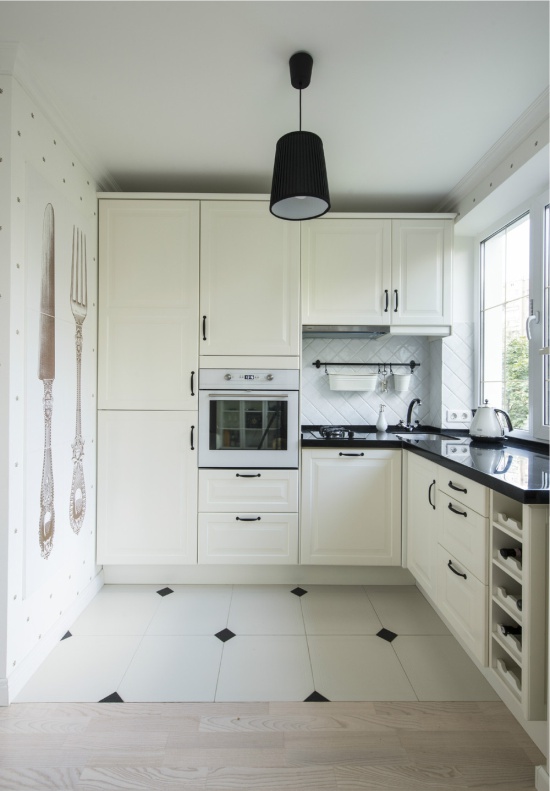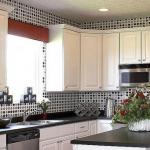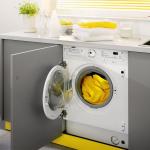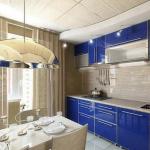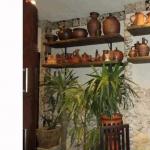Wallpapers are good because they do not require thorough plastering of the walls, as is required for painting, hide small irregularities, and also allow you to correct some of the shortcomings of the room, such as a low ceiling or a small area. And they are simply beautiful and able to transform even the most boring interior. On the other hand, the difficult conditions of the kitchen and frequent cleaning will, unfortunately, not every wallpaper. In addition, this material has a weak point - the seams, which eventually begin to peel off and wear out. We will talk about how to choose wallpaper for the kitchen so that they are beautiful, practical and serve for a long time in this material.
Overview of wallpaper types
Wallpapers come in different types, but only the following are suitable for decorating the walls of the kitchen:
- Vinyl (on paper / non-woven base);
- Non-woven (for painting);
- Glass fiber (also for painting).
Let's look at each of these types in more detail.
Vinyl wallpapers
They consist of two layers - a decorative top layer and a base. With the choice of base, everything is simple: it can be either paper or non-woven. The latter is much more suitable for decorating kitchen walls.
- Non-woven base greatly simplifies wallpapering process, because the glue is applied only to the wall. This means that its consumption is halved, and the canvases do not stretch or shrink when dried (joining the pattern becomes easier). In addition, the non-woven base better levels out small bumps and cracks in the walls, and also allows you to peel off the wallpaper easily and without residue.
Depending on the top decorative layer, vinyl wallpapers are divided into 4 main types:
- Paintable foam vinyl wallpaper;
- Compact vinyl;
- Hard vinyl;
- "Kitchen Vinyl"
Wallpaper for painting made of foamed vinyl are not suitable for finishing the kitchen, as they are not sufficiently resistant to brush friction, shock, and scratches. But the rest of the species should be taken into account.
- Wallpaper from "kitchen" vinyl they are attracted by the fact that they can withstand wet cleaning with a brush and even cleaning products. However, such a “super washable” coating is airtight, which means that a favorable environment for mold can form under it. If the walls of the kitchen were once affected by a fungus, the room is poorly lit, it is damp, pipes often leak or windows sweat, then this option will not work. If you still decide to choose them, then the walls should be pre-treated with an antiseptic primer.
- Compact vinyl wallpaper they are great for the kitchen, as they withstand light wet cleaning, are resistant to shock and scratches, their pattern does not fade in the sun, and their service life is about 10 years. In addition, the price of compact vinyl coating is not high (compared to hard vinyl), and the choice of designs is very large. But they also have a typical disadvantage for vinyl - the lack of breathability. When choosing such wallpapers, you should, firstly, treat the walls with an antiseptic primer, secondly, often ventilate the room, and thirdly, make sure that it is not damp, the pipes do not flow, and the windows do not fog up.
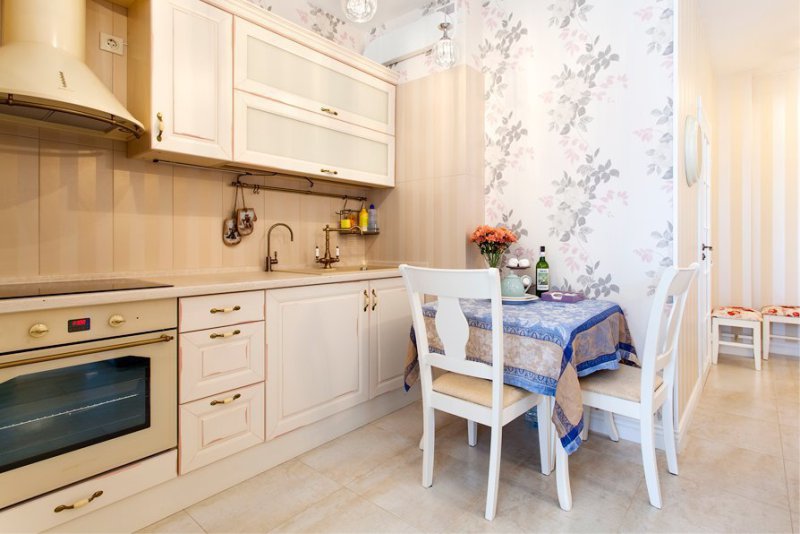
- Hard vinyl wallpaper- the best choice for the kitchen if you want to wallpaper with a pattern, and not for painting. After all, their properties are almost perfect - they are beautiful, durable, withstand wet cleaning, resistant to UV rays, and most importantly, they have micropores that will not allow the walls to "bloom" due to, say, accidental flooding. The only drawback is the high price (from 2000 rubles / roll).
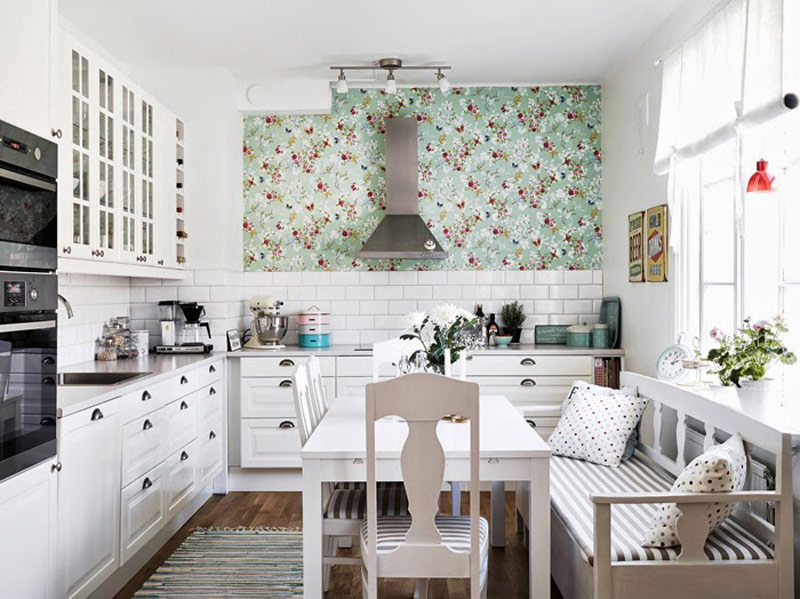
Swedish hard vinyl wallpaper
Non-woven wallpaper for painting
The term "non-woven wallpaper" always causes confusion among buyers and even some sellers. So, for example, non-woven wallpaper is often called any non-woven wallpaper (whether paper or vinyl). And this name was also assigned to wallpaper for painting made of foamed vinyl based on non-woven fabric, which we talked about a little earlier. But, strictly speaking, non-woven wallpaper has the right to be called paintable wallpaper, consisting of 100% non-woven fabric.
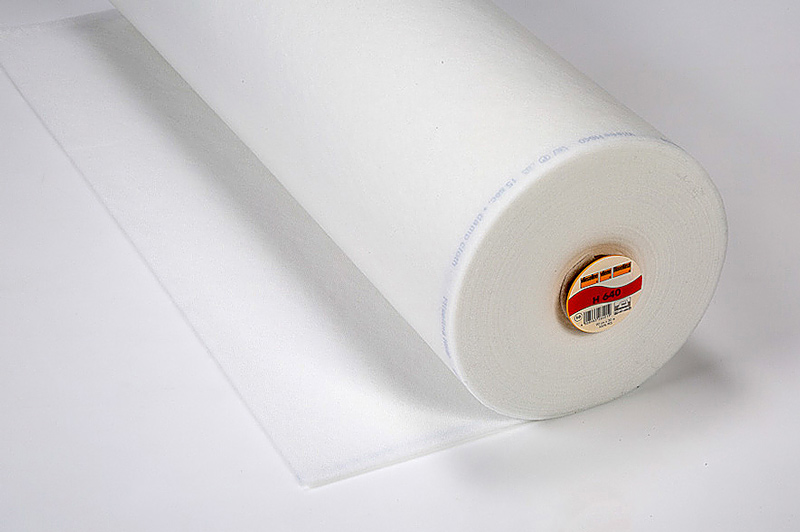
- Non-woven wallpaper for painting has no relief and looks more like paper. And this is paper, only improved by the addition of cellulose-binding polymers.
Why are they needed if they do not have any decorative effect even in the form of a relief for a simple matting? They help out when you want to paint the walls, but the foundation is far from ideal, or, for example, when cracks are expected due to shrinkage of a new building.
- It is very easy to glue non-woven wallpaper, but the joints of the canvases can be noticeable even after painting. Do walls painted on a smooth interlining or a putty wall differ? Yes, quite a bit, but they differ due to the translucent texture of non-woven fabric. Water-based paints are suitable for painting filiseline wallpaper. You can repaint them 4-5 times.
Glass wallpaper
There is no stronger wallpaper than fiberglass, made from a mixture of quartz sand, soda and lime.
- Glass fiber is more resistant to mechanical damage than vinyl for painting, and unlike smooth non-woven wallpaper, they have a beautiful relief or pattern. By the way, due to its structure, glass wall-papers visually align the walls with small differences. They are not afraid of wet cleaning, fire-resistant, elastic and well hide the defects of the base. And glass wallpaper can be repainted up to 10 times, that is, twice as often as wallpaper for painting other types.
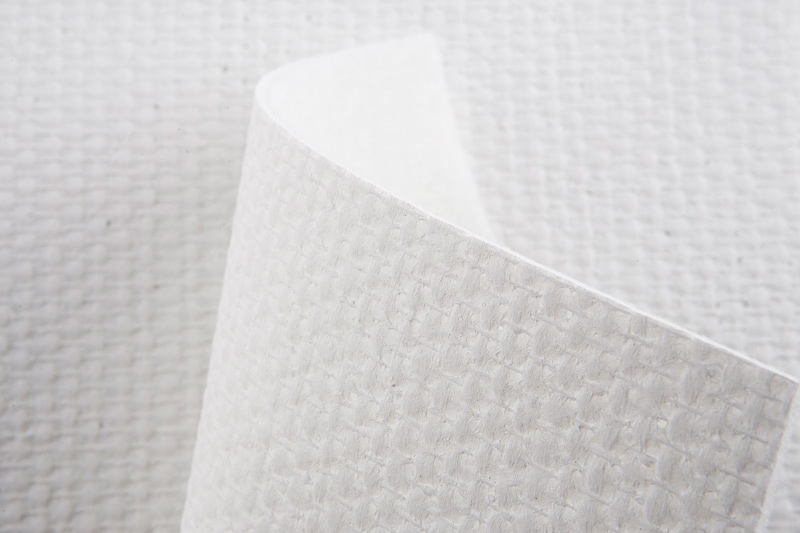
And some more useful information. Some glass wall papers are already produced in color, but they can still and preferably be painted. Paints must be water-based (acrylic, water-dispersion, water-based).
Buyer Information
- Before paying for the purchase, be sure to make sure that all rolls come from the same lot (the lot number is indicated on the package). Otherwise, despite the same article, color and collection, you will get wallpapers of different colors, which will be very noticeable when gluing the paintings on the wall. By the way, the different tone of wallpaper from different batches is not a marriage, but a technical feature of production.
- Wallpaper should always be bought with a 5-10% margin, which will come in handy in case of damage to the paintings during gluing or in the future for local repairs. If you buy wallpaper with a pattern, do not forget to take into account the rapport (pattern repetition step).
- Keep in mind that it is not necessary to glue the wallpaper behind the kitchen set. But it is desirable that the wallpaper go behind the cabinet by 10-15 cm.
- When choosing kitchen wallpapers, read their markings on the packaging. It is important that they are:
- Light-resistant - look for the sign of the sun, and preferably the sun with a plus, if the wallpaper is very bright or dark;
- Moisture resistant - look for at least two waves (they say that the wallpaper is washable and can be wiped with a damp cloth), and preferably three waves (super washable, which can be washed with a mild cleaner);
- Friction resistant- a wave with a brush indicates that the wallpaper can be washed and rubbed with a brush.
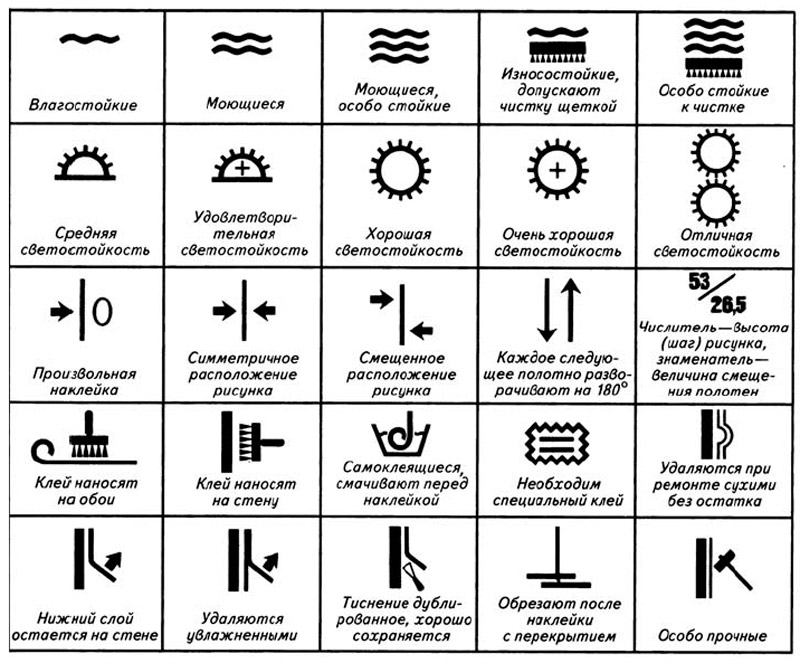
- When choosing wallpaper glue, be guided by whether it is suitable for your primer and wallpaper of the type you have chosen.
- Remember that in the bright store lighting, the exhibited samples look a little lighter than in real conditions on the kitchen wall of an ordinary city apartment.
- When designing a kitchen, two types of wallpaper can be combined (for example, super washable "kitchen" wallpaper in the cooking area and hard vinyl wallpaper in the dining area). Thus, it will turn out to save on materials and reduce the load on a more expensive coating.
- If you like wallpapers that are not durable, then just stick them on one wall, away from the stove. For example, in the dining area. The rest of the walls are best just painted with a suitable shade or combined with other wallpapers.
Photo gallery and design tips
- Wallpaper with a large, dark or bright and / or very colorful pattern is best glued to only one or two walls. Otherwise, the space will “overload” and visually decrease. It is also desirable that the interior of the kitchen with bright wallpaper be decorated in a neutral way.
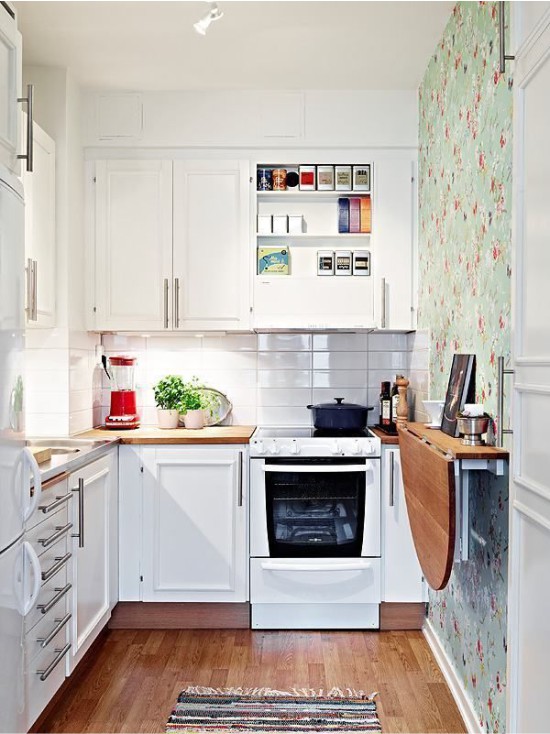
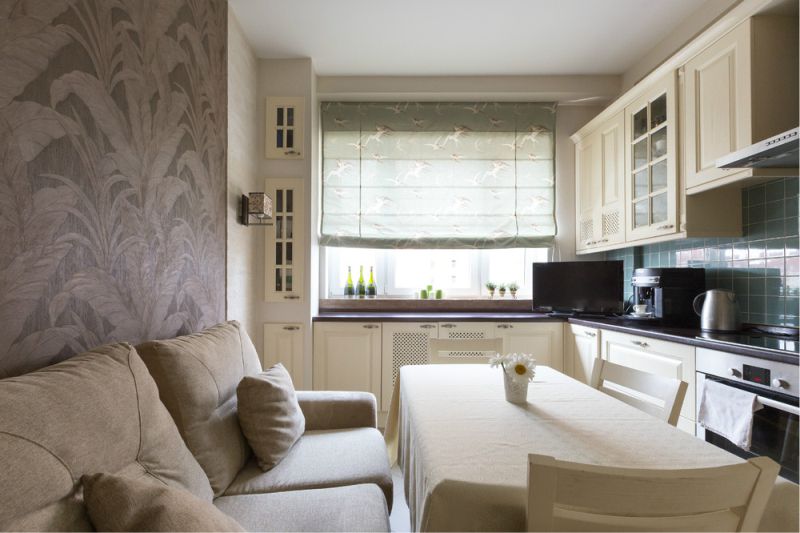
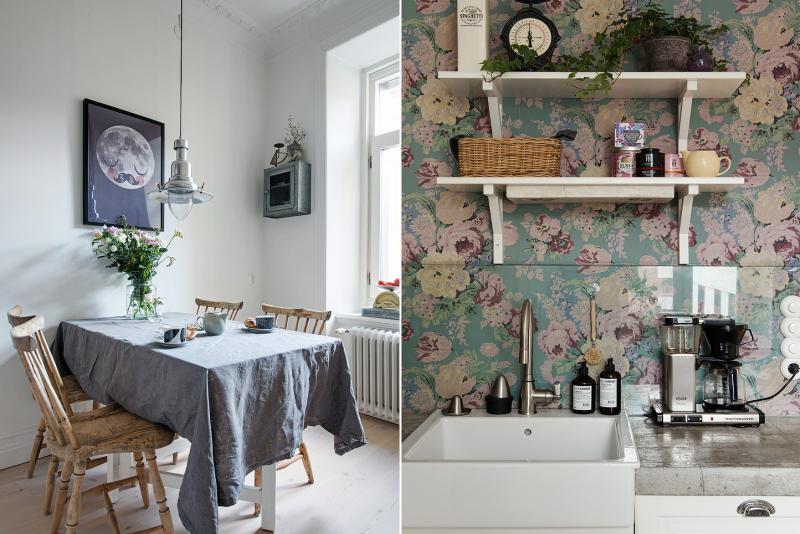
- Walls small kitchen it is best to simply paint on the wallpaper in one tone with light paint or decorate with wallpaper with a small, soft and unobtrusive print.
